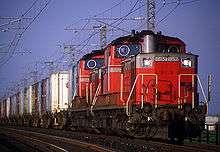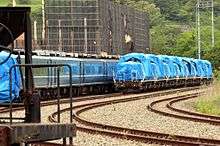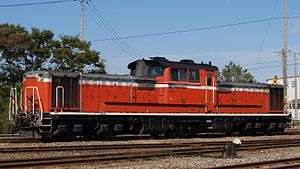JNR Class DD51
|
DD51 1027 in October 2007 | |||||||||||||||||||
| |||||||||||||||||||
| |||||||||||||||||||
| |||||||||||||||||||
| |||||||||||||||||||
The Class DD51 (DD51形) is a B-2-B wheel arrangement diesel-hydraulic locomotive type operated in Japan since 1962. 649 locomotives were built between 1962 and 1978 by Kawasaki Sharyo, Hitachi, and Mitsubishi. The class was designed for mainline passenger and freight use with more power than the D51 and a higher maximum speed than the C62 steam locomotive classes. This was achieved by installing two 1,100 hp engines in an 18 metre long centre-cab design, unusual for mainline operation. The V12 DML61 engines were developed from the 6-cylinder inline DMF31 engines used in the Class DD13 locomotives.[2]
Variations
Locos numbered from DD51 501 to 799 and from 1001 to 1186 were equipped to operate in multiple, and locos numbered DD51 800 to 899 and 1801 to 1805 were built without steam generators for train heating.[2]
Liveries
All locomotives numbered from DD51 2 onwards were finished in the standard diesel livery of orange/red with grey upper surfaces separated by a white stripe. Re-engined locos operated by JR Freight in Hokkaido sport a livery based on the Class DF200 colour scheme, with no white stripe. These locomotives were used in pairs double-heading freight trains.
JR Hokkaido locos were all finished in the "Hokutosei" livery of blue with a gold stripe and shooting star logo. These were used in pairs for hauling sleeper trains (Hokutosei, Cassiopeia, and Twilight Express) between Hakodate and Sapporo.[3]
DD51 592 (now withdrawn), and now DD51 791, was repainted in the "Euroliner" livery of pale blue with dark blue stripes for use with JR Central's "Euroliner" Joyful Train set.
DD51 842 was designated as the Imperial Train locomotive. Whereas regular members of the class have white handrails and edges to the running boards, they are polished stainless steel on this particular locomotive, as are the exhaust shrouds. Based at Takasaki Depot, it is also used for special excursion trains.[3]
 DD51 842 on an Imperial Train working in October 2001
DD51 842 on an Imperial Train working in October 2001- DD51 1095 in JR Hokkaido Hokutosei livery in February 2010
 JR Central DD51 791 in Euro Liner livery
JR Central DD51 791 in Euro Liner livery DD51 1166 in JR Freight blue livery initially applied to refurbished locomotives, July 2006
DD51 1166 in JR Freight blue livery initially applied to refurbished locomotives, July 2006 DD51 1803 in JR Freight red livery applied to refurbished locomotives, August 2007
DD51 1803 in JR Freight red livery applied to refurbished locomotives, August 2007
Refurbishment

Many of the JR Freight locomotive underwent life extension refurbishment, which included removal of steam generator equipment where still fitted. These locos are distinguished by a new livery of blue with grey upper surfaces separated by a white stripe, and cream end panels.
DD51 class locomotives also formed the basis for the DD17, DD18, and DD19 self-propelled snow plough units.[3]
Fleet allocation

As of 1 April 2016, excluding those locomotives operated by JR Freight, there were 17 Class DD51s still in service, with five operated by JR Hokkaido, four by JR East, and eight by JR West.[4]
Overseas operations
A number of Class DD51 locomotives have been shipped to Myanmar for use on the Myanmar Railways.[5]
As of March 2016, the status of DD51s shipped to Myanmar is as follows.[5]
| Original number | Manufacturer | Date built | Last owner | Date withdrawn | Date shipped | MR number(s) | Status |
|---|---|---|---|---|---|---|---|
| DD51 797 | Hitachi | November 1972 | JR Freight | March 2003 | 2004 | D2D.2201 | Stored out of use |
| DD51 823 | Hitachi | August 1970 | JR Freight | June 2005 | 2005 | D2D.2202 | Status unknown |
| DD51 1070 | Mitsubishi | February 1974 | JR Freight | December 2005 | 2005 | DD.1101 | Cut up May 2015 |
| DD.1102 | Stored out of use | ||||||
| DD51 1001 | Mitsubishi | October 1972 | JR Freight | December 2005 | 2005 | DD.1103 | Stored out of use |
| DD.1104 | Status unknown | ||||||
| DD51 1006 | Mitsubishi | November 1972 | JR Hokkaido | December 2008 | 2012 | DF.2027 | Awaiting conversion |
| DD51 1068 | Mitsubishi | February 1974 | JR Hokkaido | December 2008 | 2012 | DF.2012 | Awaiting conversion |
Conversion included re-gauging from 1,067 mm (3 ft 6 in) to 1,000 mm (3 ft 3 3⁄8 in) and lowering the cab roof profile.[5] Locomotives DD51 1070 and DD51 1001 were heavily rebuilt with parts from other locomotives to form four Bo-Bo wheel arrangement locomotives used for depot shunting work.[5]
Preserved examples
As of April 2016, seven class DD51 locomotives are preserved:
- DD51 1: Preserved at the Usui Pass Railway Heritage Park in Gunma Prefecture.[6]
- DD51 548: Preserved at Crawford Park in Mikasa, Hokkaido.[6]
- DD51 610: Preserved at the Mikasa Railway Village in Mikasa, Hokkaido.[6]
- DD51 615: Preserved at the Otaru Museum in Otaru, Hokkaido.[6]
- DD51 756: Preserved at the Kyoto Railway Museum in Kyoto since April 2016.[7]
- DD51 1040: Preserved at the Railway History Park next to Namikawa Station in Kameoka, Kyoto.[6]
- DD51 1187: Preserved at the Tsuyama Railroad Educational Museum in Tsuyama, Okayama.[8]
The prototype, DD51 1, with its unique, more rounded appearance, was moved to the Usui Pass Railway Heritage Park in April 1998 and repainted in its original livery of brown with white lining. This locomotive was withdrawn March 1986, and was subsequently stored at Takasaki Depot from March 1987.[1]
 Prototype DD51 1 preserved at the Usui Pass Railway Heritage Park in April 2011
Prototype DD51 1 preserved at the Usui Pass Railway Heritage Park in April 2011- DD51 548 preserved at the Mikasa Railway Village in Hokkaido in May 2007
- DD51 610 preserved at the Mikasa Railway Village in Hokkaido in May 2007
- DD51 615 preserved at the Otaru Museum in Hokkaido in August 2009
 DD51 756 preserved at the Kyoto Railway Museum in October 2016
DD51 756 preserved at the Kyoto Railway Museum in October 2016 DD51 849 at the Railway Technical Research Institute (RTRI) facility in Kokubunji, Tokyo in October 2001
DD51 849 at the Railway Technical Research Institute (RTRI) facility in Kokubunji, Tokyo in October 2001
See also
References
| Wikimedia Commons has media related to JNR DD51. |
- 1 2 3 Ishii, Yoshitaka (2004). DD51物語 [The DD51 Story]. Tokyo, Japan: JTB Can Books. ISBN 4-533-05661-X.
- 1 2 Inoue, Kōichi (1999). 国鉄機関車辞典 [JNR Locomotive Encyclopedia]. Japan: Sankaido. pp. 176–177. ISBN 4-381-10338-6.
- 1 2 3 JR全車輌ハンドブック2006 [JR Rolling Stock Handbook 2006]. Japan: Neko Publishing. 2006. ISBN 4-7770-0453-8.
- ↑ JR気動車客車編成表 2016 [JR DMU & Coaching Stock Formations - 2016] (in Japanese). Japan: Kotsu Shimbunsha. 22 June 2016. p. 233. ISBN 978-4-330-69016-2.
- 1 2 3 4 Saito, Mikio (October 2016). ミャンマーに渡ったDD51 [The DD51s shipped to Myanmar]. Japan Railfan Magazine (in Japanese). Vol. 56 no. 666. Japan: Koyusha Co., Ltd. p. 149-151.
- 1 2 3 4 5 Sasada, Masahiro (25 November 2014). 国鉄&JR保存車大全2015-2016 [JNR & JR Preserved Rolling Stock Complete Guide 2015-2016] (in Japanese). Tokyo, Japan: Ikaros Publications Ltd. p. 123. ISBN 978-4863209282.
- ↑ 京都鉄道博物館 [Kyoto Railway Museum]. Japan Railfan Magazine (in Japanese). Vol. 56 no. 662. Japan: Koyusha Co., Ltd. June 2016. p. 4852-53.
- ↑ Shibata, Togo (February 2016). 2016年「津山まなびの鉄道館」としてリニューアルオープン [Reopening in 2016 as "Tsuyama Railroad Educational Museum!]. Tetsudō Daiya Jōhō Magazine (in Japanese). Vol. 45 no. 382. Japan: Kōtsū Shimbun. p. 46-47.


